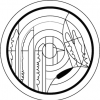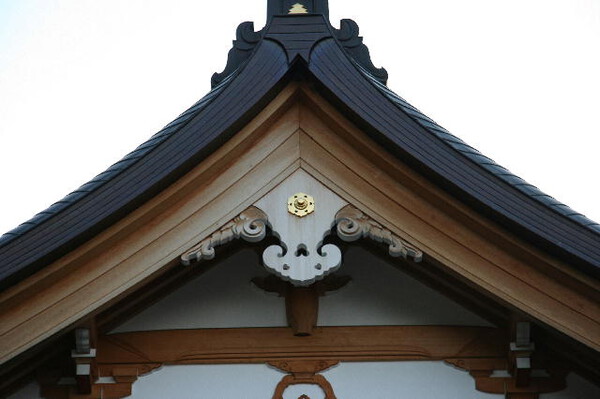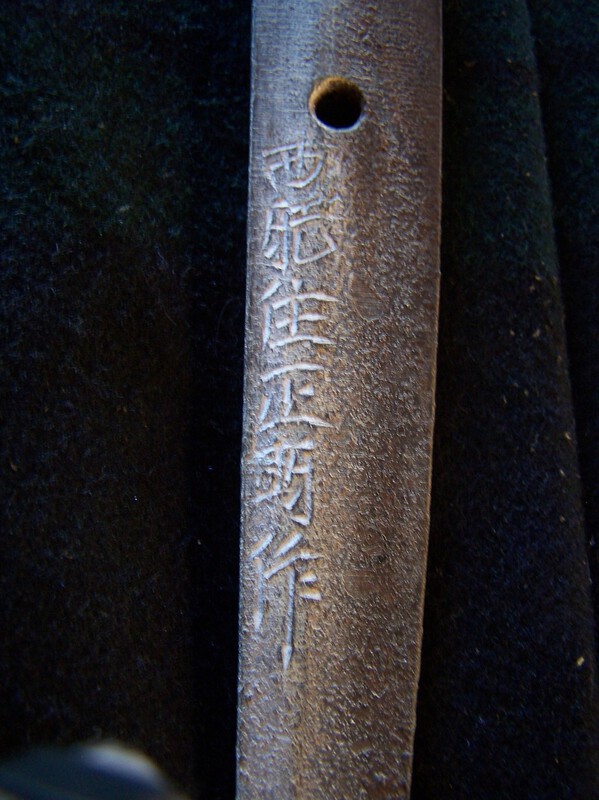-
Posts
995 -
Joined
-
Last visited
-
Days Won
12
Content Type
Profiles
Forums
Events
Store
Downloads
Gallery
Everything posted by Ted Tenold
-
To clarify the NBTHK events at the San Francisco Token Kai; The NBTHK American Branch will host an exhibit and lecture on kodogu on Friday, August 7th, at 2:00 pm. NBTHK members from all branches are free admission (please bring your membership card if your membership is with the Tokyo or European Branches as we only have rosters for American Branch members), non-members are welcome to attend for a nominal admission fee. Usually this is $10 to $20, but the fee has not yet been determined. On Saturday August 8th, from 1:30 pm to 3:00 pm, the NBTHK-AB will host an exhibit and lecture on Tanto open to NBTHK members only. Immediately following the lecture will be a forum also for NBTHK members only.
-
A recent development has just come to to my attention that replacement Hozon and Tokubetsu Hozon papers are now possible. I don't have details on this yet, but will let everyone know more info as soon as it is available to me. The NBTHK American Branch website is also in the process of redesign and will have updated information regarding shinsa, fees, schedules, etc. when it is launched. Replacement Juyo and Tokuju papers have been available for years but require the item be sent to the NBTHK in Tokyo for verification and documentation. I suspect the process will be similar for Hozon and Tokubetsu Hozon replacements. Obviously, for those outside Japan, the process quickly becomes complicated, and for swords, expensive with all the associated import/export procedures. Stay tuned for more details...
-
I'd be interested in knowing also. A name would be better than calling them "those little pointy thingies". They do bear a fair resemblance to "gegyo" 懸魚 , the architectural detail found in the gables of Japanese roof design. Gegyodome???
-
Maru is rare and as Darcy mentioned tends to be associated with Aoe school works. I have a wakizashi with marumune consigned for sale on my site, and the papers attribute it to late Uda. I cannnot recall having seen another Uda sword with marumune. It's so infrequently encountered, even the judges missed it on the notation sheet when it went through shinsa.
-

Item Held Up In Us Customs
Ted Tenold replied to reeder's topic in Auctions and Online Sales or Sellers
I had researched a ray species a while back and came up with Trygon Sephen in an old book. Darcy's info confirmed that it's the same species, just under the more contemporary binomial he listed. One small correction is that shirasaya and saya/tsuka foundations (including the liners in gunto saya) are made from Honoki which are the species of either Magnolia Obovata (Japanese Big Leaf Magnolia), or Magnolia Hypoleuca (Japanese Whitebark Magnolia). Neither of these species are threatened, or species of concern, though Sayashi still tend to lament a diminishing supply of nice shirasaya worthy stock. :-) It's good to have these names on file also in case you are asked. http://www.iucnredlist.org/details/193981/0 Kiri (Paulownia) is used for boxes and furniture among other things and is also grown extensively in the Southern US as a decorative and also for sustainably harvested lumber. An interesting characteristic of Kiri is its' low thermal conductivity. It has about twice the ignition temperature, which makes it more fire resistant than most other hardwoods. -

Wwii Japanese Sword With A Tachi Blade From Kamakura Period?
Ted Tenold replied to cplnorton's topic in Nihonto
I was wondering if anyone would notice, but the two stamps on the face of the fuchi dai read "Tsuka Hei Maki". This is the mark of a highly respected tsukamakishi named Shukichi Yamaguchi. He died in 1966 iirc. The stamp may have remnant of red ink also. Unusual that it is stamped twice on your tsuka. Usually only one stamp on the few I've seen. You should try to protect and conserve it as best as possible because his work is rare and getting even more so with time. I think these mounts, while not top tier, are better than average quality gunto mountings. I'm not familiar with the corporate mark on the tsuba, which is similar to Suya Company, but definitely not the same one. The officer certainly had enough money and pride to have an old blade mounted in respectable mounts to carry into the fray. There's an article by Bob Benson out in the ethernet somewhere about Tsukahei. It used to be on his site, but looks like its been removed. -

A big thank you and recommendation
Ted Tenold replied to Brian's topic in Auctions and Online Sales or Sellers
Everything that Darcy pointed out is spot on. I learned of the plastic wrap thing from Bob Benson many years ago. I added some of my own elements of protection and prevention also. I also write the tracking number on the outside of the package in two opposed locations. Sometimes the paperwork can get damaged, lost, wet, or stripped and then they'd have to open to the package. If the number is on the outside, they can still reference it and reprint a label or waybill without having to do so. Emailing the paperwork to the recipient is a matter of completing the communication circle for all involved so if customs or the carrier contacts the recipient, questions can be answered between them with the same documents in hand. It all takes a fair amount of time to generate, collate, and organize, but ends up making things much smoother in the end. On occasion there is a hiccup, but it's usually because of things way beyond normal control, and a knowledge of a particular country's proclivity for certain problems or concerns arms you with the ability to make appropriate additions or adjustments to a shipment destined to that country. It's an ever evolving and changing environment so we have to constantly stay informed. In general though, more paperwork is better. It's the staple food of bureaucracies, so feeding the machine is by and large a healthy approach. There are also a variety of details such as export filing requirements, import and export fees, etc., that have to be considered, and certain countries do things in just randomly weird ways. As an example; one country requires the weight of the import item to be declared by "hundred kilo" and no other way. :? @ Jean; If I remember correctly, I contacted a trusted friend to pick it up and ship it to me, and then I shipped it to you. I don't have a son, though it would be nice to have a genetically indentured servant once in a while. -

South Manchuria railway company presentation Tachi
Ted Tenold replied to Medina San1's topic in Military Swords of Japan
Indeed a very good find. There are not many of these in complete and good condition. My understanding is that they were produced as gifts to employees that had reached 25(?) years of service, and as gifts to VIP's. I have seen two here in the US, of which one was missing some parts, and heard rumor of another complete one in the UK, but never confirmed. I have pictures of the complete one in my archive somewhere. I think I may have posted some images of it here way back when also. Iirc, the complete example I saw also had two mekugi ana. I suspect because the blades were pulled out of the production line and then fitted to the tachi koshirae. There is sometimes some very interesting memorabilia from the South Manchurian Railway Company available on ebay and Train Enthusiast sites. -
Hard to make out a couple of them. The kaisho on the right looks like Masa Ki(?) Shige..Yoshi(?) The katakana on the left looks like maybe Mi Ka(?) ...(?) Te(?) :? Maybe Morita-san can offer a suggestion?
-
So many varieties. I've seen kesho migaki that included signatures (one was in very nice sosho), kao, dates, wood burl designs, and some just plain weird. Some are so bad, they're just an eyesore. Top craftsman's are amazingly precise and accent the polish magnificently. Here is an interesting and unique combination.
-
Hi Brian, I've encountered this problem before. As a fly fisher I learned this a long time ago rather than bust the ferrules on a $400 fly rod, and have used it with stuck shirasaya also. It does work. With Tanto, the technique might be a little more dodgy due to both handlers being in tight quarters, so use good judgement there. I've never had the need to implement it with a tanto though. A third person gently striking the hand of the person holding the tsuka closest to the koiguchi (as is done to loosen the tsuka normally) can help break the seal so the holders can apply consistent pulling force without trying to jerk it apart too erratically. Hope it helps.
-
@Joe; It was nice to see you at the show, and I'm glad you had the chance to look at some nice swords. For clarity though, the swords are consignment pieces, not my own, and I photograph under Darcy's keen eye and patient instruction. :-) They are indeed a great pleasure to behold rivaling top swords "behind glass" in Japan and elsewhere. I remember showing you the sword you mentioned having difficulty seeing the utsuri a few years ago at one of the NBTHK/AB display and lectures. That sword was a katana by Tairyusai Sokan, a shinshinto sword. While he is known for utsuri in his works it's a lot more subtle than the Ichimonji. It takes time to train the eyes to see the subtlety of that particular work and it wasn't the best starting platform for you. Ichimonji, especially Fukuoka which tend to be more flamboyant and vibrant, are the perfect candidate for study of such a feature. The other Ichimonji also have it in varied degrees, but really it also depends greatly on the health of the sword. The steel at the original surface of the sword when it was quenched receives the brunt of the violence in the process and the fingerprint of that interaction is most vibrant there. As the sword is polished down, the features become dimmer, muddy, blurred, patchy, or disappear altogether. In Japan a few years ago, I was shown an Ichimonji that was quite frankly, in stunning health, and the utsuri was actually *streaming* on the surface in bright shades. It was amazing. Undoubtedly, polishing diminishes this vibrance over time, so seeing the layering effect such as in the one pictured above, is also indicative of seeing a sword in excellent health and we don't have to construct much of an image in our minds of what it looked like the day it was first delivered. Regarding the polishing; no one really knows to what degree swords were polished in the Kamakura Jidai. Our image of polishing today is biased by the development of materials and techniques used pretty much since Meiji. Before that, polishing incorporated some different stones (which are now no longer available as the quarries are exhausted), higher quality of the same used today, and there were other schools which likely had some individual techniques and applications. I did once have the opportunity to see a sword that was in it's first and original polish from 1859. The foundation was well attended, but the finish was dull, in sashikomi style, and lack luster. It was ordered and intended as a diplomatic gift, so it was nothing about it was a half measure. Had it not remained in an especially dry and amenable environment for over 100 years, it probably would have been corroded, but even the original shirasaya was in good condition (though inferior in craft by today's standards). Obviously polishes don't last forever especially in Japan's environment and during periods of constant warfare. However, we know that terms such as "utsuri" have been used and associated since early koto times, and that the reproduction of such a feature was a target of the makers, controllable or not, consistently repeatable or not. Therefore the state of polishes has to be sufficiently clear to identify the feature and give it a name. Other crafts in Japan required a fairly sophisticated knowledge of polishing, such as would be necessary for mirror makers and lacquer artists so it's not unreasonable that polishing of swords could have been quite sophisticated even if only the best swords were polished to the highest degree, with lesser works receiving only fundamental polishing/honing as weapon maintenance . Really vivid utsuri can be revealed somewhat early in the polishing process and even weaker utsuri should be identifiable by the uchigumori stone (the last in the foundation work). The shiage stage of polishing refines it and other features further. @Gasam; The Craft of the Japanese Sword by Yoshindo Yoshihara, and Leon and Hiroko Kapp has Yoshihara san's description of the conditions under which he creates utsuri. I believe there was an article some years ago regarding the theories of clay-less (or very slight application of clay) heat treating authored by Shannon Hogg, and there is at least one contemporary smith in Japan that has experimented with the technique with some compelling results showing that it is possible. One bladesmith here in the US has also created an impressive example of heat treating without clay or refractory cement (commonly used by smiths outside Japan instead of traditional composition).
-
The strong black chikei like lines can be seen with retempers. Also the indistinct habuchi, inconsistent and hajimi looking yakiba, the otherwise glassy and faded looking hada, the blistery and dry looking nakago. Not saying it's absolute, and the polish certainly isn't helping matters, but those are my observations from the images.
-
No disrespect intended to anyone or anyone's mentor, but I wouldn't rule out Saiha either.
-
http://en.wikipedia.org/wiki/Russell's_teapot
-

well this is not something you see every day
Ted Tenold replied to Darcy's topic in General Nihonto Related Discussion
Yup, you are correct. For some reason I had cherry trees stuck in my head when I answered. My bad... -

well this is not something you see every day
Ted Tenold replied to Darcy's topic in General Nihonto Related Discussion
It is a stylized plum tree (ume). Near the monouchi you will a group of five circles around a central sixth, which is the plum blossom. Another is about center the length of the blade. The bamboo and plum, along with the cherry tree are the "three friends of winter" or "Shochikubai". -
Looks like maybe Yasushige to me.
-

High-end manji habaki by Mr Tschernega
Ted Tenold replied to Marius's topic in General Nihonto Related Discussion
Just for clarity; while manji are present within it, the design is actually called "sayagata". Brian has made some extraordinary habaki for me also, and as Barry mentioned, their fit are always impeccable. -
Standard Samurai GPS unit. :lol: I'm with Pete on this; I think modern. Interesting none the less!
-
:lol: Yup, it got a snicker!
-
Thank you one and all! I read Seihi and based on the second kanji thought it might be in the Saga or Kumamoto areas, but wanted confirmation. The aki kanji was a mystery though, so thank you again for your help.
-
Anyone care to have go at this one? Very odd residence name, and the closest I can derive for the second kanji of the smith name is "hisa"??





